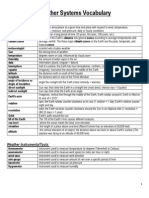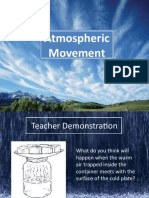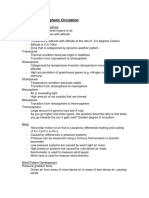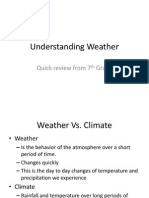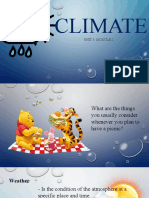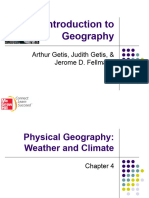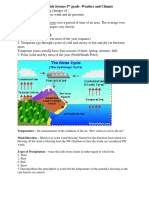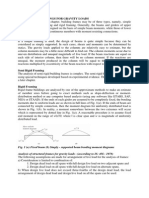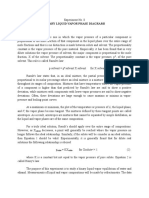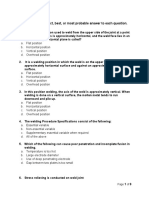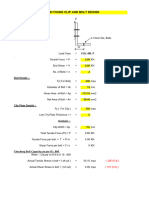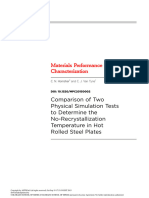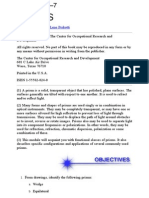Weather and Climate
Dr. Mohamed Babiker Ibrahim
Definition of weather and climate
The air (Atmosphere) is made of gases.
The Atmosphere is formed of layers such as the Troposphere, Stratosphere and the Mesosphere.
Life and weather exist within the Troposphere. Weather means the condition of temperature, wind, air pressure,
humidity and precipitation that recorded in specific time (one hour or half a day).
Climate means the elements of weather that gathered over extended period of time, i.e. 35 years.
Air Temperature:
The sun is the main source of energy on earth and it is called solar energy.
It is also called solar radiation or insolation.
It is transformed into heat at the earth’s surface or the atmosphere.
Its availability depends on the intensity and duration of radiation from the sun.
The intensity is determined by the angle at which the sun’s rays strike the earth.
The duration of radiation is determined by the number of daylight hours.
High solar intensity is found at the equator and decreases towards the poles.
Earth Inclination:
The earth spins on its axis which is titled 23.5 away from the perpendicular.
Every 24 hrs the earth rotates once on its axis which results in day and night, and it is revolving around the sun in
one years and this brings us the different seasons. Because of the inclination of the earth’s axis, solar energy which
is received at a given latitude is not the same during the course of the year. Vertical rays of the sun will be felt at lat.
23.5 N in June 21(summer solstice of N. Hemisphere and winter solstice of S. Hemisphere). On Sept. 21and March
21(Equinoxes) rays of the sun strikes the equator. In these days hours of day and night will be equal everywhere in
the world. About December 21rays of the sun strikes near lat. 23.5 S which marks the first day of the summer
solstice of the S. H. and winter solstice of the N. H.
The inclination of the earth’s axis is also means the length of day and night varies during the year. At the equator the
daylight extends for 12 hrs. each day of the year. In the northern summer daylight becomes 24 hrs in the N. Pole and
darkness becomes 24 hrs in the S. Pole.
Reflection and Reradiation:
Solar radiation is lost through reradiation and reflection. Rays of the sun come to earth as shortwave energy (light)
and reflected back to the atmosphere as long- wave terrestrial radiation (heat).
Therefore, atmosphere is heated from the ground and not directly from the sun.
68% of the solar energy will be absorbed by the earth and atmosphere, and 32% will be reflected back to the space
and atmosphere.
Lapse rate:
It means the decrease of temp. with altitude in an average of:
6.4 C per 1000 meters, or
3.5 F per 1000 ft.
Sometimes rapid reradiation causes temp. to be higher above the earth’s surface than at the surface itself.
This is what is called temperature inversion.
1
� Air Pressure and Winds
Air is made of gases and it has a weight. One cubic inch of air with the height of 6 miles weigh 14.7lbs or 6.67 kgs.
Areas of cold and warm air are both found on the earth surface. Since cold air is heavy, it is always descending and
creates an area of high air pressure. Since warm air is lighter it has the tendency to ascend and creates an area of
low air pressure.
Winds flow from the area of H.P to the area of L.P. The greater the differences in air pressure between places the
greater the wind (pressure gradient force).
Convection system:
The motion of descending cool air and ascending warm air is called Convection.
A good example of a convectional system is land and sea breezes as well as mountain and valley breezes.
A - Sea breeze:
1- During the day warmer air in the land rises up and creates an area of low air pressure.
2- Air over the sea is cooler. Since it is heavier it descends and creates an area of high air pressure on the
sea.
3- Therefore, wind will be moving from the area of H.P.(Sea) to the area of L.P.(Land).
4- This wind movement from sea to land is called Sea Breeze.
B- Land breeze:
1-During the night warmer air rises up over the sea and creates an area of low air pressure on the sea.
2-Air over the land is cooler. It descends and creates an area of high air pressure over the land.
3-Wind moves from the area of H.P. (land) to the area of L.P. (sea).
4-Such movement of wind from land to sea is called Land Breeze.
C- Mountain and valley breezes:
During the night heavy cold air over the snow that found at the top of mountains descends to the lower part of the
valley. Therefore, the valley will be much cooler than the mountain slopes. This is called Mountain Breeze. Valley
Breeze is caused by warm air moving up slopes during the day in mountainous regions.
Coriolis Effect means the wind that moves from H.P. to L.P, deflects to the right in the N. hemisphere and to the
left in the S. H. This takes place because of the rotation of the earth on its axis.
Wind Belts
There are 3 main wind belts in each Hemisphere. An example from N. H.
1- Northeast Trade Wind:
Equatorial areas are zones of L.P. Intense heat causes air to ascend creating an area of L.P. This warm air
cools in the high altitudes and becomes heavy and falls in areas 30 degrees N. and S. of the equator
forming areas of H.P. This H.P. area is called Sub-Tropical High Pressure.
When the air of the Sub-Tropical H. P. reaches the surface, some of it moves towards the equator forming
the NE Trade Winds (lower latitudes 0-30 N).
2- The other part of the Sub-Tropical H flows towards the pole between 30 and 60 N (mid latitudes) forming
the second wind belt. This wind is called the Westerlies. The names refer to the direction from which the
wind comes. Most of USA lies within this second belt.
3- The 3rd wind belt is found in the upper latitudes between 60 N to 90 N. It is called the Polar
Easterlies. In this belt wind moves from the areas of High Polar Pressure to Sub-Polar Low
Pressure along Latitude 60 N.
2
� Types of Precipitation
Precipitation means water in any form (rain; snow and hail) deposited on the earth’s surface.
There are three types of precipitation:
These are Convectional, Orographic and Cyclonic or Frontal.
1- Convectional Precipitation:
It results from the rising of the warm moisture-laden (warm air + water vapor) air. When it reaches higher altitudes,
it cools. When it reaches the dew point, condensation (cloud formation) start and then followed by precipitation.
This process is typical of the summer showers of the continental climates and the tropical storms that fall in
afternoons. They are highly localized and last for a short period of time. They are also accompanied by lightning,
thunder and heavy rainfall.
2 - Orographic Precipitation:
It occurs when a warm moisture-laden air is blocked by the existence of a hill or a mountain. Therefore, such air
will be forced to rise. Accordingly, the process of cooling, condensation and precipitation will take place at the
Windward side. Dry wind will pass over the mountain and it doesn’t bring rain to the other side which is called
Leeward side (Dry side) or Rain Shadow.
3- Cyclonic or Frontal Precipitation:
This type of precipitation is common in the mid-latitudes, where cold and warm air masses meet.
Air masses are large bodies of air with similar temperature and humidity. They are formed over a source region,
such as the cold land area of Canada (cold and dry air mass) and the tropical areas (warm and humid air mass).The
leading edge of the air mass is called Front. When the two air masses meet together, the heavy cold air mass forces
the light warm air mass to rise. The rising air forms an area of low pressure. With the rising warm air, the process
of cooling, condensation and frontal or cyclonic precipitation occurs. This is called a storm or a mid-latitude
cyclone. A cyclone may be a weak storm or one of great intensity. The Hurricane is an intense tropical storm or
cyclone.
Climates of the World
The two important criteria of climatic classification are temperature and precipitation. In climate the year is
divided into halves (winter and summer).
1- Tropical Rain Forest is a hot climate that receives rainfall the year round. Although it has dense forests,
but it has been greatly affected by Deforestation.
2- The Savanna is also a hot climate that receives rainfall during the summer. Since it is rich of grasses it is
also rich of animal resources. This is the climate in which farmers practice traditional farming.
3- The Semi-Arid is a hot climate that receives rainfall during the summer. The amount of rainfall allows the
growth of grasses and not crops.
4- The Hot Desert is a hot dry climate. Rainfall is rare and sporadic. Trees and shrubs are found along the dry
streams.
5- The Mediterranean is a hot and dry climate during the summer. The Westerlies are responsible for
bringing rainfall in winter.
